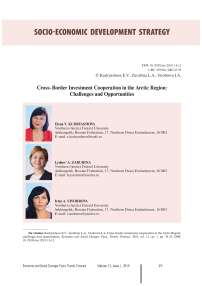Cross-border investment cooperation in the arctic region: challenges and opportunities
Автор: Kudryashova Elena V., Zarubina Lyubov A., Sivobrova Irina A.
Журнал: Economic and Social Changes: Facts, Trends, Forecast @volnc-esc-en
Рубрика: Socio-economic development strategy
Статья в выпуске: 1 (61) т.12, 2019 года.
Бесплатный доступ
The article considers the investment processes that take place in the foreign and Russian Arctic, the tools to attract investment and the possibility of accumulating best practices in the implementation of investment projects. Analysis of the data on planned, unfinished and cancelled projects in the Russian and foreign Arctic, including joint projects, allows us to reveal problems in cross-border investment cooperation. In the framework of global economic challenges, when discussing the opportunities for the Northern regions alternative to large-scale production and transportation, we determine the need to find new promising areas of investment, including infrastructure projects. On the basis of official, statistical and expert assessments, we analyze the priorities and directions of investment activities in the Arctic and the main tools to increase investment attractiveness and promote investment. We consider European Neighbourhood and Partnership Instrument (ENPI) Kolarctic 2007-2013 as an analytical case, since it is one of the most effective tools for providing financial support to multilateral cross-border cooperation projects in the Barents Euro-Arctic Region...
Arctic region, cross-border investment cooperation, large-scale infrastructure projects, kolarctic cooperation program, best investment practices, investment attractiveness strategy
Короткий адрес: https://sciup.org/147224137
IDR: 147224137 | УДК: 339.924 | DOI: 10.15838/esc.2019.1.61.2
Текст научной статьи Cross-border investment cooperation in the arctic region: challenges and opportunities
circumstances. The problem of investment attractiveness for the regions of the European North of Russia is the key one in achieving effective socio-economic development. In principle, financial sources of investment are limitless for any country and for any region in the world market economy. The only problem is how to attract investment in this particular country or region. In the list of investment areas it is worth noting the importance of large-scale infrastructure projects for sustainable economic development of Russian regions. It is necessary to concentrate not only on the current, fastacting tools for regulating the investment climate, which is currently important, but also on those areas that will affect the deep processes and factors (efficiency, balance, diversification of resources and potentials) and will be able to determine a significant improvement in the investment situation of the European North of Russia in the long term. Cross-border cooperation programs, the role of which is still underestimated, contribute to accelerating the development of the infrastructure of territories. The goals of our study are as follows: to substantiate the fundamental importance of cross-border investment cooperation in the development of the Arctic territories, to summarize best practices of this interaction under European programs, and to develop recommendations for a strategy to increase the investment attractiveness of the Northern territories. To achieve these goals, it is necessary to reveal the problems and identify the promising areas for cross-border investment cooperation in the Arctic region, as well as to analyze direct and indirect tools for attracting investment used in foreign practice.
Review of conceptual approaches and the research methodology
The object of the study is the investment processes taking place in the foreign and Russian Arctic, the tools to attract investment, and the possibility of accumulation and dissemination of best practices. All investment projects can be grouped into national, international and cross-border according to the criterion of location of the territories and countries participating in them. Cross-border issues are considered in the works of S.P. Bystritskii, A.G. Granberg, V.K. Zausaev, N.M. Mezhevich, P.A. Minakir, P.A. Mitskevich, M.Yu. Shinkovskii, etc. Currently, both nearborder and cross-border cooperation is a field of interdisciplinary research. The concepts based on the theories of new regionalism, social constructivism, and neoliberal institutionalism mainly refer to the political and sociological approaches generalized in the thesis of A.P. Sologub [2]. Political research also extends to the Arctic regions [3, 4], while the discussions on investment cooperation involve officials of the Arctic countries [5] and representatives of international Arctic organizations [6]. Studies on the need for cross-border reform of legal mechanisms are also the sphere of formation of new scientific concepts in jurisprudence [7, 8]. Geographical theories are based on spatial and resource concepts [9, 10], a significant contribution in this direction is made by Professor A. Pilyasov [11], an authority on the Northern regions and the Arctic. There are no clearly defined economic concepts of cross-border cooperation; researchers consider certain aspects of this process: methodological tools for assessing investment attractiveness [12], mechanisms to ensure the movement of investment flows [13], and the effectiveness of the use of entrepreneurial resources within the framework of cross-border cooperation [14]. Although the majority of economic concepts agree that the business partnership of neighboring countries is one of the effective mechanisms for accelerated and sustainable development of border areas [15, 16], some researchers focus on national security issues. For example, D.A. Medvedev, an expert at the Center for Strategic Assessments and Forecasts, focuses on the prospects and directions of international economic cooperation in the Arctic megaregion, taking into account national interests [17]. We think that cross-border cooperation has a number of distinct economic advantages over national and international cooperation:
-
1. A more stable and predictable environment for mutual trade than in multilateral trade negotiations, where the interests of the participants are very different.
-
2. Exemption from strict administrative regulations from the federal center; transfer of key decisions to regional centers (constituent entities of the Russian Federation) and local authorities.
-
3. Immediate geographical proximity of the border region, the presence of a common border and communications, historically established economic ties simplify the trade process by reducing transaction costs.
-
4. Common regional interests in terms of sustainability (environmental requirements and standards, etc.).
-
5. Establishment of public-municipalprivate partnerships for infrastructure investment.
-
6. Support and encouragement of local producers (especially small enterprises that do not have a strong export potential), for which a wider regional market is emerging.
-
7. Establishment of direct market relations between entrepreneurs with the prospect of establishing joint ventures.
Due to the fact that many important economic problems of countries intersect directly at the border, cross-border cooperation can act as a kind of pilot site, contributing to the solution of certain issues of inter-state
Table 1. EU financing of infrastructure projects initiated by the Russian partner within the framework of ENPI CBC for 2007–2013
|
Leading partner |
Program |
Sphere |
Number of projects |
EU financing, euros |
|
Kaliningrad Oblast |
LT-PL-RU |
Healthcare |
2 |
4476821 |
|
Housing and utilities |
2 |
3304500 |
||
|
Tourism |
1 |
1227634 |
||
|
Leningrad Oblast |
SEFR |
Road infrastructure |
2 |
6840000 |
|
Republic of Karelia |
KAR |
Road infrastructure |
2 |
3480000 |
|
Compiled with the use of [18]. |
||||
relations, including those on which it is difficult or impossible to make a decision at a higher level.
Taking all this into consideration, we used methods of content analysis of strategic documents of the Arctic countries, reports of state institutions and development institutions on investment activities and cooperation, as well as methods of analysis of databases on Arctic projects and statistical methods.
Analysis of foreign experience allows us to draw conclusions about the comprehensive use of both direct and indirect tools to attract investment5. Due to the weak investment attractiveness of the Arctic projects, due to high investments and significant risks, the major part of financing is carried out at the expense of budget expenditures. Direct state financing of investments in the Arctic territories is implemented in two aspects: either to develop the infrastructure, or to support local communities and equalize the level of income6. The challenges associated with the development, maintenance and operation of infrastructure lead the governments of the Arctic powers to the conclusion that it is necessary to create new mechanisms of publicprivate and multinational partnerships.
The European Neighborhood and Partnership Instrument (ENPI CBC), which includes six programs with Russian partici-pation, was subjected to a more detailed study from these positions. Fifty-four leading Russian partners and 490 Russian project partners participated in the first period of ENPI CBC implementation [18].
The Kaliningrad and Leningrad oblasts, as well as the Republic of Karelia took the most active part in the initiation of large-scale infrastructure projects (Table 1).
The list of the regions attractive to investors contains very few infrastructure projects implemented in the territory of the Arctic Zone of the Russian Federation7. At the same time, according to the US investment firm Guggenheim Partners, over the next decade, the Arctic will require about one trillion of investment in infrastructure, including transport, telecommunications and social services, to support a new era of economic opportunities ranging from energy, fisheries and mining to defense and tourism [19, 20]. The database includes 900 planned, incomplete, completed, cancelled and prospective Arctic infrastructure projects. Russia is far ahead of its neighbors, with nearly 250 potential projects (Fig. 1).
Figure 1. Estimated investment requirements, billion USD
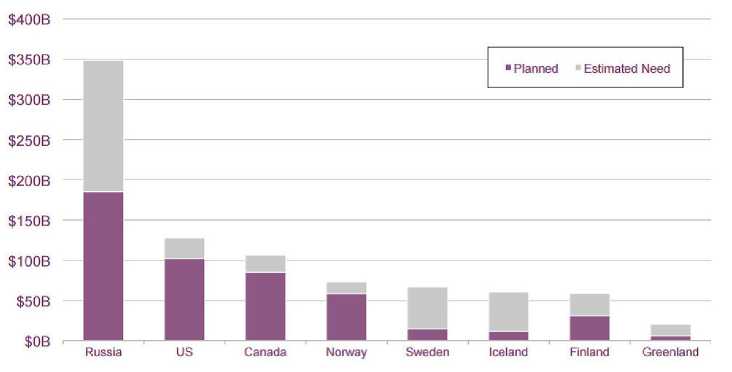
Source: Guggenheim Partners Endorses World Economic Forum’s Arctic Investment Protocol.
According to the European Commission report (2017), the EU priorities in the formation of future funding programs will focus on the following key investment projects in the Arctic [21]:
-
• sustainable fishery and marine resources, including aquaculture (Greenland), other marine industries(Faroe Islands), and reindeer husbandry and hunting (Saami Council);
-
• mining, mineral and other resourcebased industries, as well as the chemical industry, in order to improve their environmental sustainability and integration into the multi-turn economy (Sweden and Greenland);
-
• bioeconomics (Sweden and Finland) and bioindustry based on the timber and agroindustrial complex, as well as marine, water and other natural resources (Northern Sparsely Popular Areas (NSPA) in Norway, Sweden and Finland);
-
• metallurgical, machine-building and machine-tool industries (NSPA in Norway, Sweden and Finland);
-
• information and communication technologies (Finland), including digitization
of health and social services, and robotics (NSPA in Norway, Sweden and Finland);
-
• telecommunications and electronic technology (Norway), as well as the development of 5G networks, Printed Intelligence, data security, big data and the Internet of things;
-
• satellite technology, including Galileo, GPS, Glonass and Beidou systems, as well as digital services and automatic vehicle management via satellite navigation (Finland);
-
• energy production, in particular the use of renewable sources such as biofuels and hydro-, wind and tidal energy, as well as energy recovery from forest waste and resource efficiency (NSPA in Norway, Sweden and Finland) and the development of hydropower and small networks (Greenland);
-
• services facilitating navigation and other marine activities in the North Atlantic and Arctic (Faroe Islands and Denmark), remote operation of ships (Finland);
-
• sustainable and environmentally friendly tourism that respects the environment (Greenland, Iceland and the Saami Council), and joint development of tourism products
with more effective transnational cooperation (NSPA in Norway, Sweden and Finland);
-
• creative industries (Faroe Islands);
-
• healthcare (Finland) and natural sciences (Faroe Islands and Sweden).
Long-term sustainable cross-border cooperation is one of the most important factors in stimulating investment activity in the Northern territories [22, 23]. This is consistent with the Arctic Investment Protocol of the World Economic Forum, which provides six goals for investors in relation to responsible investment in the Arctic8:
-
• Build resilient societies through economic development.
-
• Respect and include local communities and indigenous peoples.
-
• Pursue measures to protect the environment of the Arctic.
-
• Practice responsible and transparent business methods.
-
• Consult and integrate science and traditional ecological knowledge.
-
• Strengthen pan-Arctic collaboration and sharing of best practices.
The content and the main findings of our research
Serious problems in the development of the Arctic regions have led to the realization of the need to find new points of growth, to change the established development guidelines for more environmentally and socially sustainable ones compared to resource-oriented economies, and to the need to revise development strategies [24]. The implementation of the main provisions of the progressive development scenario of the Russian Arctic is expected to be carried out through the activities of three different levels:
-
1) development of priority sectors of the Russian Arctic economy;
-
2) development of supporting infrastructure in the Arctic;
-
3) development of local Arctic life support infrastructure.
The first level includes large-scale investment projects of private companies focused directly on the production of final products, as well as the creation of the necessary auxiliary infrastructure of the main industries (pipelines, high-voltage power lines, etc.), as well as activities aimed at providing scientific support to the development of the Arctic.
The second level includes projects for development of the basic transport and infrastructure framework of the Russian Arctic, especially the new territories of its development, on the principles of public-private partnership (PPP), as well as state projects for restoration and preservation of the environment of the Russian Arctic.
The third level provides the functioning and development of local engineering and social infrastructure in the areas of old and new development.
The set of activities of the second level is considered the most resource-intensive one in terms of budget support. Within its framework, it was planned to implement measures for the construction of motor roads and railways, port facilities that were not included in the federal target program “Development of the transport system of Russia in 2010–2020”.
The implementation of these very projects could serve as a transition from a conservative to a target scenario for the development of the Russian Arctic. It is obvious that without the implementation of a number of important tasks of the second level, many large investment projects of private companies lose their relevance because of their low profitability.
Figure 2. Proportion of budget funds (budgets of all levels) in the total volume of investments in fixed assets carried out in the Arctic Zone of the Russian Federation, 2017, %
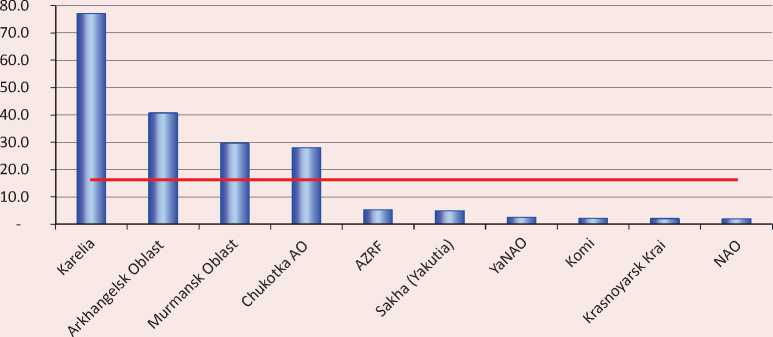
i—I RF subjects ^^^^^^^^^^^ Russian Federation
Compiled with the use of the source: The share of budget funds (budgets of all levels) in the total volume of investments in fixed assets carried out on the territory of the Arctic zone of the Russian Federation. Available at: new_site/region_stat/arc_zona/2018_2/ (accessed 11.10.2018).
We should emphasize that the cost of major infrastructure projects that are not included in other state programs and that do not have the confirmed state financial support was about 350 billion rubles for the six-year period.
The role of budget funds in the implementation of investment projects in the Arctic is shown in Figure 2.
The analysis of statistical data demonstrates the high importance of budget investments in the socio-economic development of the Russian Arctic, especially its Western part. The share of state financing in the structure of investments exceeds the average Russian level in four entities of the Russian Arctic; in all the rest, the value of this indicator is insignificant – less than 5%. The pillar zones of development in the Arctic are designed to become an effective mechanism for attracting investments, including foreign ones. The projects planned to be implemented in the territory of the Arctic
Zone of the Russian Federation (on the basis of the pillar zones) include interregional and transcontinental infrastructure projects that create fundamentally new advantages and opportunities.
At the same time, foreign experts say that investment activity in the Arctic faces a number of specific challenges9. The choice of investment strategies for the development of the Arctic territories is associated with overcoming significant barriers and finding adequate responses to existing challenges [25]. In particular, in the process of analyzing the implementation of the first period of the European Neighborhood and Partnership
Table 2. EU funding of the projects in which the leading partner is the constituent entity of the Russian Federation – in the framework of Kolarctic 2007–2013 Program
|
Constituent entity of the Russian Federation, the leading partner – program member |
EU funding of the projects |
|
|
Thousand euros |
% |
|
|
Arkhangelsk Oblast |
1,327,244 |
18.5 |
|
Nenets Autonomous Okrug |
1,588,261 |
22.1 |
|
Murmansk Oblast |
4,265,442 |
59.4 |
|
Total |
7,180,947 |
100.0 |
|
Compiled with the use of [18]. |
||
Instrument ENPI Kolarctic 2007–2013 program, the following development challenges were identified [18, 26, 27]:
-
• negative demographic trend due to net migration and declining fertility;
-
• migration of highly skilled youth to central regions;
-
• significant job losses due to industrial restructuring;
-
• limited development of the services sector and social sphere;
-
• insufficient development of logistics;
-
• lack of modern social infrastructure;
-
• huge environmental safety risks associated with current and planned production, transportation and storage of oil and gas;
-
• low level of real incomes of the population.
The tasks of identifying and assessing these challenges are difficult to tackle due to the high level of spatial and socio-economic heterogeneity of the Arctic territories.
Regional differentiation is a characteristic feature of cross-border cooperation programs implemented in the Northern territories of Russia. Thus, the analysis of the implementation of Kolarctic 2007–2013 program shows a significant scope in the volume of financing of joint projects (Tab. 2).
Fifty one projects received grant support following the results of four application rounds; only three of them belong to large-scale infrastructure projects that were implemented in the Murmansk Oblast (Kandalaksha– Alakurtti–Salla road, reconstruction of Borisoglebsk automobile border-crossing point) and in Nenets Autonomous Okrug (polar renewable energy sources).
The project field of Kolarctic Program includes several directions, but the main infrastructure projects fall under the topic of “Economic and social development” (22 projects out of 65) (Fig. 3).
Seven projects in the Arkhangelsk Oblast were supported under this program. And, despite the fact that these projects are not large-scale, specific practical tasks were solved, including the development of road infrastructure through the introduction of innovative Scandinavian ROADEX technologies. The implementation of these projects made it possible to obtain significant effects from participation in international economic integration; it helped attract significant investments and resources to the region, which made it possible to develop and introduce new ideas, technologies, methods and practices. At the same time, judging by the results of the first stage of the program, we reveal the insufficient involvement of regional authorities in the work to initiate and promote large-scale investment projects, to inform and improve the competence of regional business and specialized regional structures in the use of various tools of cooperation.
Figure 3. Distribution of approved projects according to the priorities of the program
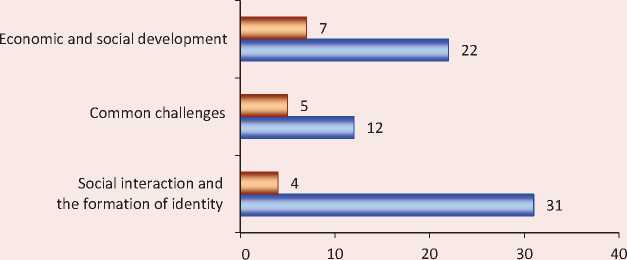
□ ArkhangelskOblast □ Total
Compiled with the use of the source: Georis P., Delcoure L., Levarlet F., Brignani N., Palloni P., Bonne M., Brophy P. Ex-Post Evaluation of 2007-2013 ENPI CBC Programmes. Brussels, 2018. Volume I: Main Report January 2018.
Figure 4. Distribution of the total budget of Kolarctic 2014–2020, broken down by types of organizations
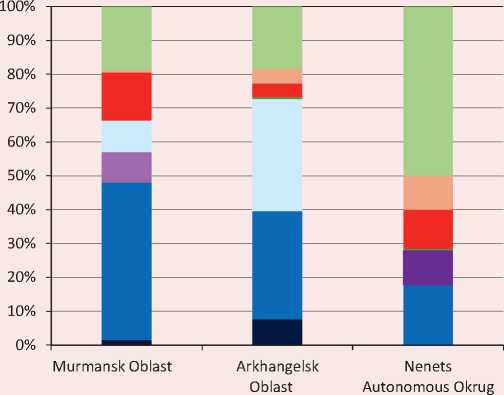
-
■ Otherstate institutions
-
■ Municipal institutions
-
■ State institutions
-
■ Other education institutions
Highereducation institutions
-
■ Research institutes
-
■ State enterprises
-
■ Private enterprises
-
■ Non-profit organizations
Compiled with the use of the source: Kolarctic CBC – Program 2014–2020: Statistical data of the applications in the second call for proposals. 8.11.2017.
The implementation of the second phase of Kolarctic 2014–2020 has already demonstrated greater involvement of different target groups and stakeholders, including private business (Fig. 4). In the Murmansk Oblast, the share of private enterprises among the partners of the program was almost 50%.
At the same time, the overall activity of the subjects of the Russian Arctic among the 15 Arctic territories remains low (Tab. 3).
The complexity of implementation of investment programs in the European Arctic is revealed in the course of joint consultations of EU institutions. The list of main problems
Table 3. Distribution of the total budget of Kolarctic 2014–2020 by regions
The overly bureaucratic nature of the process of participation in public investment program, the variability of the rules and reporting requirements are reflected in the increasing administrative burden, which is a real problem for small municipalities with limited staff, and is also seen as a negative factor in terms of economic efficiency. Stakeholders in all the countries of the European Arctic came to the conclusion that it is necessary to define eligible costs, separate direct and indirect costs, use a common set of rules to calculate charges and interpret the results, and harmonize reporting procedures and reduce financial control. In addition, one of the means to overcome funding problems is to increase revenues at the start of the projects implementation or to establish an initial fund to cover costs during the project development phase. With regard to the projects planned for implementation in the Russian Arctic, the possibility of using such tools is not even discussed.
Suggestions and conclusion
Kolarctic Program has a pronounced social orientation. Western countries understand that the discomfort of living in the North should be compensated. Indirect methods in the form of tax and financial preferences and the creation of various special development zones and marketing tools, including the branding of Arctic products, are widely used. At the same time, the forms of support take into account not the nationality of the manufacturer, but its localization in the Northern territories. Such methods are most promoted in three fields: innovative digital production, production of products with local specifics and environmentally friendly products, and the use of special Northern conditions and resources (cold climate technology and bioenergy).
However, there are still a few measures that need to be taken or improved to ensure that businesses, especially startups, have what they need in order to grow and operate in the Arctic region. The measures are as follows:
-
• providing effective financial tools to support small and medium-sized enterprises (SMEs) at various stages of their development and to overcome barriers to innovation and growth [28];
-
• providing maximum support to SMEs to help them enter international markets and find suitable sales channels and partners abroad;
-
• investments in logistics and infrastructure to support international business development [29];
-
• investing in high-quality local education, lifelong learning, and research projects.
From the point of view of the possibility of introducing foreign approaches to investment activities in the Russian Arctic, we should particularly note the positive experience of accumulating best investment practices, including public-private partnerships and municipal experience in supporting small and medium-sized businesses (for example, in Lapland). Taking into account the availability of investment passports of the Russian regions, we recommend creating banks of best investment practices in the Northern regions of Russia.
Awareness of the inertia of investment processes in the Arctic leads to the conclusion that it is necessary to develop a strategy to increase the investment attractiveness of the Northern territories, which is based on the following aspects:
-
• development of regional programs, the implementation of which in practice goes beyond the boundaries of administrative entities (“growth zones”) [30];
-
• creation of a single portal for all planned projects of the Russian Arctic;
-
• unification of requirements for participation in investment programs and projects;
-
• formation of a number of advantages for long-term investment of private capital in the development of problem areas: reduced corporate tax rates, absence of sales tax and payroll tax, subsidizing costs (“zones of opportunities”);
-
• active use of marketing tools, including the branding of Arctic products and territories;
-
• promotion of ready-to-implement infrastructure projects based on cross-border private investment cooperation;
-
• concentration of public investment in dual-use infrastructure;
-
• formation of new mechanisms of publicprivate and multinational partnership, taking into account the Arctic features of the implementation of infrastructure financing models.
In order to ensure consistency in the territorial and temporal aspects of the implementation of priority investment projects on the basis of investment strategies of constituent entities of the Russian Federation with the Arctic territories, we find it appropriate to develop a single investment strategy of the macroregion – the Arctic Zone of the Russian Federation.
Список литературы Cross-border investment cooperation in the arctic region: challenges and opportunities
- Stepanova V.V. Challenges of innovative development of the Northern macroregion of Russia. In: Finansovo-ekonomicheskoe i informatsionnoe obespechenie innovatsionnogo razvitiya regiona: sbornik materialov Vserossiiskoi nauchno-prakticheskoi konferentsii, posvyashchennoi 100-letiyu Krymskogo federal’nogo universiteta imeni V.I. Vernadskogo, 2018 g. . Pp. 92-95. Available at: https://elibrary.ru/download/elibrary_32616897_76958596.pdf (accessed 21.01.2019)
- Sologub A.P. Rol’ proektnoi deyatel’nosti v obshchestvenno-politicheskom konstruirovanii regiona Baltiiskogo morya: dis. … kand. polit. nauk . Saint Petersburg, 2016. 209 p.
- Makarov V.A. Transgranichnoe sotrudnichestvo v Barentsevom Evro-Arkticheskom regione: dis. … kand. polit. nauk . Moscow, 2000. 159 p.
- Yarovoi G.O. Transgranichnaya regional’naya integratsiya v Evrope. Problemy i perspektivy razvitiya "vneshnikh" evroregionov na primere evroregiona "Kareliya": dis. … kand. polit. nauk . Saint Petersburg, 2006. 201 p.
- Esker H., Kleist M., Horney H. Kingdom of Denmark: cooperation for sustainable economic development. The Arctic Herald, 2018, no. 1 (24), pp. 16-21. Available at: https://issuu.com/arctic-herald/docs/ah_01_2018_web2/22
- Heather N. Rescaling borders of investment: the Arctic Council and the economic development policies. Journal of Borderlands Studies, vol. 33, no. 2, pp. 225-238. Available at: https://doi.org/10.1080/08865655.2017. 1402192
- Tutunov B.M. International investment cooperation of the Russian Federation. Novyi yuridicheskii vestnik=New Legal Bulletin, 2018, no. 2, pp. 3-4. Available at: https://moluch.ru/th/9/archive/84/3133/..
- Vinnitskii D.V. Legal regime of cross-border investments in the countries of the Caspian region. Rossiiskoe pravo: obrazovanie, praktika, nauka=Russian Law: Education, Practice, Science, 2017, no. 5 (101), pp. 70-78. Available at: https://elibrary.ru/download/elibrary_32518254_63352029.pdf..
- Petukhova L.N. Formirovanie transgranichnykh ekonomicheskikh raionov (Rossiya -Severnaya Evropa): dis. … kand. geogr. nauk . Saint Petersburg, 2006. 196 p.
- Druzhinin P.V. Features of development of the near-border regions. Regionologiya=Regionology, 2017, vol. 25, no. 2 (99), pp. 200-216. Available at: https://elibrary.ru/download/elibrary_29389283_78812539.pdf..
- Pilyasov A.N., Kotov A.V. Some aspects of international economic cooperation in the Arctic. Vestnik SPbGU. Ser. 6=Saint Petersburg University Bulletin. Series 6, 2016, no. 2, pp. 81-96. Available at: http://vestnik.spbu.ru/html16/s06/s06v2/08.pdf..
- Tatarkin A.I., Balashenko V.V., Loginov V.G., Ignat’eva Z.S. Methodological tools for assessing the investment attractiveness of renewable resources in the Northern and Arctic territories. Ekonomika regiona=Economy of Region, 2016, vol. 12, no. 3, pp. 627-637..
- Elizavetin M.E. Investitsionnoe sotrudnichestvo Rossii so stranami Zapada na sovremennom etape: dis. … kand. ekon. nauk . Moscow, 2003. 152 p.
- Kravtsova I.V. Prigranichnoe sotrudnichestvo kak faktor razvitiya predprinimatel’stva v transgranichnom regione (na primere Primorskogo kraya): dis. … kand. ekon. nauk . Vladivostok, 2008. 189 p.
- Khodachek A.M. Cross-border economy in the new industrialization of Russia: coordination of strategies of the North-West of Russia and the Baltic Sea Region. In: Novaya industrializatsiya Rossii. Teoreticheskie i upravlencheskie aspekty: koll. monogr. . Saint Petersburg: NPK "ROST", 2014. Pp. 112-120..
- Osadchaya O.P., Remizov D.V. Osnovnye formy organizatsii prigranichnogo sotrudnichestva . Rubtsovsk: Rubtsovskii industrial’nyi institut, 2013. 155 p. http://www.rubinst.ru/files/static/vuz/doc/nauka/Ocadchaja_Remezov_monograf.pdf
- Medvedev D.A. Mezhdunarodnoe ekonomicheskoe sotrudnichestvo v Arktike. Arkticheskii ekonomicheskii sovet . Moscow: ANO TsSOiP, 2015. 92 p. (Problemy bezopasnosti v Arktike, 3). Available at: http://csef.ru/media/articles/6381/596d498587cca7a046270b1181136097.pdf (accessed 11.10.2018).
- Georis P., Delcoure L., Levarlet F., Brignani N., Palloni P., Bonne M., Brophy P. Ex-Post Evaluation of 2007-2013 ENPI CBC Programmes. Brussels, 2018.
- Carney G. Guggenheim Partners Endorses World Economic Forum’s Arctic Investment Protocol. Available at: https://www.guggenheimpartners.com/firm/news/guggenheim-partners-endorses-world-economic-forums (accessed 28.07.2018).
- Minerd S. Sustainable Development: the Future of Investing. Available at: https://www.guggenheiminvestments.com/institutional/perspectives/global-cio-outlook/sustainable-development-the-future-of-investing (accessed 10.10.2018).
- Greunz L., Ward T. Summary report of the Arctic Stakeholder Forum consultation to identify key investment priorities in the Arctic and ways to better streamline future EU funding programmes for the region. Luxembourg: Publications Office of the European Union, 2017. Available at: https://publications.europa.eu/en/publication-detail/-/publication/6a1be3f7-f1ca-11e7-9749-01aa75ed71a1/language-en/format-PDF/source-60752173 (accessed 11.10.2018).
- Novoselov A., Potravny I., Novoselova I., Gassiy V. Selection of priority investment projects for the development of the Russian Arctic. POLAR SCIENCE, 2017, vol. 14, pp. 68-77.
- Kondrat’eva N.B. Russia-EU: cross-border cooperation beyond the conjuncture. Sovremennaya Evropa=Modern Europe, 2014, no. 4 (60), pp. 33-47. Available at: https://elibrary.ru/download/elibrary_22026024_67165658. pdf..
- Schulze V. Arctic Strategies Round-up 2017. Available at: http://www.arctic-office.de/fileadmin/user_upload/www.arctic-office.de/PDF_uploads/Arctic_Strategies_EN_10.11.17.pdf (accessed 01.10.2018).
- Kapyla J., Mikkola H. The promise of the geoeconomic Arctic: a critical analysis. ASIA EUROPE JOURNAL, 2016, vol. 14, no. 2, pp. 203-220.
- Myllylä M., Cicero V. Fiftyone: Information about 51 Kolarctic ENPI CBC Projects. Lulea, 2015. 54 p.
- Khod’ko T.S. International vector of development of the Arctic. The Arctic Herald, 2017, no. 1 (20), pp. 48-51. Available at: https://issuu.com/arctic-herald/docs/ah_01-2017_web/52..
- Longi H., Niemelä S., Tervonen P. Arctic innovation hubs: opportunities for regional co-operation and collaboration in Oulu, Luleå, and Tromsø. The Northern Review, 2017, no. 45, pp. 77-92. Available at: https://doi.org/10.22584/nr45.2017.005
- Gunnarsson B. Three Steps in Addressing Logistical Challenges in the Arctic. Available at: http://www.chnl.no/publish_files/CHNL_Seminar6_1_Three_Steps_in_Addressing_Logistical_Challenges_in_the_Arctic.pdf (accessed 08.08.2018).
- Gao Tianming. Cooperation between Russia and China in the Arctic in the format of pillar zones. Vestnik universiteta=University Bulletin, 2018, no. 4. Available at: https://cyberleninka.ru/article/n/sotrudnichestvo-rossii-i-kitaya-v-arktike-v-formate-opornyh-zon..

